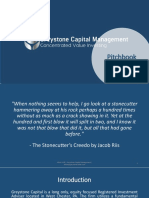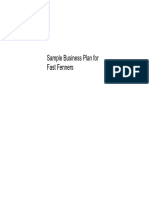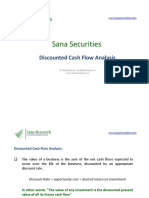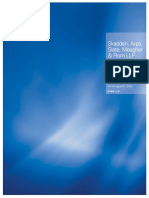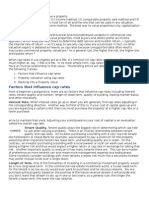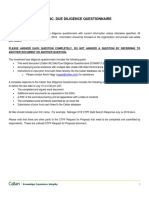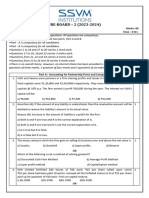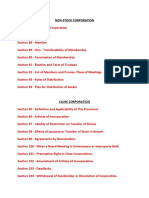0 ratings0% found this document useful (0 votes)
REPE Case 03 Sao Paulo Opportunistic Pre Sold Condos Slides
REPE Case 03 Sao Paulo Opportunistic Pre Sold Condos Slides
Uploaded by
Brado DelgadoThis document outlines a real estate private equity case study involving the development of luxury condos in Sao Paulo, Brazil. The case examines whether an investment of R$40 million would achieve a targeted 2x multiple and 25% IRR. It finds that the assumptions around costs, timelines, and prices are risky and that returns would just barely meet targets in an optimistic scenario. Overall, the recommendation is not to proceed with the investment given uncertainties around confirming key assumptions.
Copyright:
© All Rights Reserved
Available Formats
Download as PDF, TXT or read online from Scribd
Download as pdf or txt
REPE Case 03 Sao Paulo Opportunistic Pre Sold Condos Slides
REPE Case 03 Sao Paulo Opportunistic Pre Sold Condos Slides
Uploaded by
Brado Delgado0 ratings0% found this document useful (0 votes)
This document outlines a real estate private equity case study involving the development of luxury condos in Sao Paulo, Brazil. The case examines whether an investment of R$40 million would achieve a targeted 2x multiple and 25% IRR. It finds that the assumptions around costs, timelines, and prices are risky and that returns would just barely meet targets in an optimistic scenario. Overall, the recommendation is not to proceed with the investment given uncertainties around confirming key assumptions.
Original Description:
REPE Case 03 Sao Paulo Opportunistic Pre Sold Condos Slides
Copyright
© © All Rights Reserved
Available Formats
PDF, TXT or read online from Scribd
Share this document
Did you find this document useful?
Is this content inappropriate?
This document outlines a real estate private equity case study involving the development of luxury condos in Sao Paulo, Brazil. The case examines whether an investment of R$40 million would achieve a targeted 2x multiple and 25% IRR. It finds that the assumptions around costs, timelines, and prices are risky and that returns would just barely meet targets in an optimistic scenario. Overall, the recommendation is not to proceed with the investment given uncertainties around confirming key assumptions.
Copyright:
© All Rights Reserved
Available Formats
Download as PDF, TXT or read online from Scribd
Download as pdf or txt
0 ratings0% found this document useful (0 votes)
REPE Case 03 Sao Paulo Opportunistic Pre Sold Condos Slides
REPE Case 03 Sao Paulo Opportunistic Pre Sold Condos Slides
Uploaded by
Brado DelgadoThis document outlines a real estate private equity case study involving the development of luxury condos in Sao Paulo, Brazil. The case examines whether an investment of R$40 million would achieve a targeted 2x multiple and 25% IRR. It finds that the assumptions around costs, timelines, and prices are risky and that returns would just barely meet targets in an optimistic scenario. Overall, the recommendation is not to proceed with the investment given uncertainties around confirming key assumptions.
Copyright:
© All Rights Reserved
Available Formats
Download as PDF, TXT or read online from Scribd
Download as pdf or txt
You are on page 1/ 18
Real Estate Private Equity 101
• Purpose: Just like with normal PE firms and
LBOs… use debt and equity to acquire a
property, grow it over time, and then sell it
• That same housing analogy applies… but here,
it really is a house we’re buying!
• But… the modeling itself might be much simpler,
or possibly more complex
This Tutorial
• Part 1: The Types of RE PE Case Studies
• Part 2: This Case Study and What Makes It Tricky
• Part 3: Doing the Quick Math on This Deal
• Part 4: Assumptions and Construction Timeline
• Part 5: Equity and Debt Draws (and More)
• Part 6: Investment Recommendation
Three Types of RE PE Cases
• Opportunistic: Build a new property or completely
revamp (“redevelop”) an existing one
Three Types of RE PE Cases
• Key Question: How much is the property changing?
This Case Study
• Property: V:House – High-end luxury condos in
São Paulo – to be developed and pre-sold
• Question: Should we pay R$ 40 million to fund
the property’s development if we’re targeting a
2x multiple and a 25% IRR?
• Other Terms: Spelled out in the document –
Base Case, Downside Case, and Upside Case
with different selling price / Hard Cost etc. figures
This Case – Typical Opportunistic Scenario
• Purpose: This one’s a mix of calculations and
market data, but the modeling isn’t that complex
• Market Data: Less about forecasting trends and
more about confirming/denying initial figures
• Prerequisites: Must be good with Excel (IF,
OFFSET, INDEX/MATCH, EOMONTH, etc.) and
finance / RE fundamentals (waterfalls, debt, etc.)
What’s Tricky About This Case…
• Problem #1: Brand-new, high-end development in
Brazil… what assumptions are reasonable?
• Problem #2: How much debt and equity can we
use… exactly?
• Problem #3: How quickly can we pre-sell the units?
• Solution: Develop the property, use as little equity
as possible, and pre-sell as quickly as possible!
What’s Tricky About This Case…
• Trick: Wrapping your head around the “pre-sold”
concept and how the returns trickle in over time
• But: Also have a strict 1-week time limit, so you
need to move quickly with the Excel formulas
• So: Spend some time on market data, but mostly
pay attention to the instructions at the end, and
jump into Excel more quickly
The Quick Math on This Deal
• Key Insight: If the rough numbers don’t work, why
would an even more complex model work?
• Conclusion: We’re already skeptical – even 50-60%
leverage won’t boost the multiple to 2x in most cases
Assumptions and Timeline
• Can’t do much in this type of model – can’t even build a
S&U schedule since we don’t know debt/equity yet
• But we do challenge the original case study numbers for
Hard Costs – they don’t foot with reality / other sources
Assumptions and Timeline
• Timeline: Need to jump into Excel to explain…
• Step 1: Set up an area that tracks total units sold, %
sold, month #, year #, etc.
• Step 2: Create a tracking area for each phase
• Step 3: Finish Phase I, fill in info. at the top, move to II
• Step 4: Complete this process for Phases II and III
Assumptions and Timeline
• Step 5: Split the monthly sales into Initial vs.
Construction-Phase vs. Final Deposits
• Simplification: Instead of getting the Construction ones
“right,” we just take the cumulative sum of the values of
units sold so far, multiply by 30%, and divide by 24
• Think About: What would it take to get this “right”?
Expenses, Equity & Debt & Other
• Expenses: Hard Costs based on Gross Sq. M.
only if something is under construction, and the
others are percentages of monthly sales
• Equity: Do we have negative Gross Income, and have
we not yet passed 40% of all units pre-sold?
• If so, draw on equity… 20% from developers and 80%
from investors
Expenses, Equity & Debt & Other
• Equity: Also, check to see if we’re in the final
month or the end of all construction, and if so,
repay remaining debt!
• Debt: Draw on if we have negative Gross Income and
we’re past 40% of all units pre-sold; repay debt principal
when we can, and accrue interest when we have to
Waterfall Returns Schedule
• Same idea as in the other RE PE case studies…
• Track: Equity the investors contribute each month
• Increase By: Monthly amount that corresponds to 20%,
25%, 30%, etc. annual return
• Subtract: Distributions received because of positive
cash flows in the month
Summaries and Sensitivities
• Monthly Model: Very “unwieldy,” so you should create
an annual summary and a transaction summary
• Key Items: Sources & Uses, Returns, Construction
Timeline, and Physical Building Profile; for annual model,
revenue, expenses, cash flows, and IRR/multiples
• Sensitivities: Focus on most impactful assumptions
(selling prices, hard costs, lot prices, sales velocity)
The Investment Recommendation
• Point #1: In a very optimistic case, we just barely meet
the 2x targeted multiple; and we don’t in the Base Case
• Point #2: Market data isn’t that favorable / we lack the
data to confirm many key assumptions
• Point #3: Might work if the construction finished more
quickly, or if we could lock in Hard Costs at R$ 4,000 /
sq. m., or if we could guarantee higher selling prices…
but those all seem tough
Recap of This Tutorial
• Part 1: The Types of RE PE Case Studies
• Part 2: This Case Study and What Makes It Tricky
• Part 3: Doing the Quick Math on This Deal
• Part 4: Assumptions and Construction Timeline
• Part 5: Equity and Debt Draws (and More)
• Part 6: Investment Recommendation
You might also like
- REPE Case 02 45 Milk Street Investment RecommendationNo ratings yetREPE Case 02 45 Milk Street Investment Recommendation20 pages
- RE 01 05 Industrial Development Case StudyNo ratings yetRE 01 05 Industrial Development Case Study5 pages
- RE 01 02 Simple Office Acquisition AfterNo ratings yetRE 01 02 Simple Office Acquisition After2 pages
- Corvex Capital - The Case For Change Now at CWHNo ratings yetCorvex Capital - The Case For Change Now at CWH80 pages
- Investor Relations Update: February 2020No ratings yetInvestor Relations Update: February 202027 pages
- REPE Case 01 Lyric Apartment AcquisitionNo ratings yetREPE Case 01 Lyric Apartment Acquisition17 pages
- KPMG Atlantic Yards Market Study Aug. 31, 2009No ratings yetKPMG Atlantic Yards Market Study Aug. 31, 200948 pages
- Real Estate & REIT Modeling: Course Outline: What Others Are Saying About Our Modeling Courses..No ratings yetReal Estate & REIT Modeling: Course Outline: What Others Are Saying About Our Modeling Courses..19 pages
- Eastdil Secured - 201610 Puget Sound Market OverviewNo ratings yetEastdil Secured - 201610 Puget Sound Market Overview21 pages
- Mapletree Commercial Trust Annual Report 2015-16No ratings yetMapletree Commercial Trust Annual Report 2015-16160 pages
- Corvex Capital - Restoring The Health To Commonwealth - 2013.02.26No ratings yetCorvex Capital - Restoring The Health To Commonwealth - 2013.02.2669 pages
- 2020 Data Threat Report Global Edition ReportNo ratings yet2020 Data Threat Report Global Edition Report36 pages
- VP Portfolio Manager Underwriter in Orlando FL Resume Donna WeeksNo ratings yetVP Portfolio Manager Underwriter in Orlando FL Resume Donna Weeks2 pages
- Report - Private Schools For Public GoodsNo ratings yetReport - Private Schools For Public Goods116 pages
- L.E.K. Consulting: Clean Label PerspectivesNo ratings yetL.E.K. Consulting: Clean Label Perspectives16 pages
- Finding The Right Financing Mix: The Capital Structure DecisionNo ratings yetFinding The Right Financing Mix: The Capital Structure Decision145 pages
- Arch Advisory LTD: Providing Exceptional Support and SuccessNo ratings yetArch Advisory LTD: Providing Exceptional Support and Success17 pages
- Sustainable Balkans Growth Fund Slide Deck January 2023 - Final DraftNo ratings yetSustainable Balkans Growth Fund Slide Deck January 2023 - Final Draft32 pages
- RE 01 09 Hotel Acquisition Renovation SolutionsNo ratings yetRE 01 09 Hotel Acquisition Renovation Solutions7 pages
- Taxation of Dividend: Change in Dividend Taxation Regime Under Finance Act, 2020No ratings yetTaxation of Dividend: Change in Dividend Taxation Regime Under Finance Act, 20204 pages
- An Asian Direct and Indirect Real Estate Investment AnalysisFrom EverandAn Asian Direct and Indirect Real Estate Investment AnalysisNo ratings yet
- HDFC Bank Limited Recruitment and Selection Process1100% (1)HDFC Bank Limited Recruitment and Selection Process197 pages
- PRE-BOARD - 2 (2023-2024) : Grade: XII Marks: 80 Subject: Accountancy Time: 3 HrsNo ratings yetPRE-BOARD - 2 (2023-2024) : Grade: XII Marks: 80 Subject: Accountancy Time: 3 Hrs8 pages
- DFD Diagram Restuarant Orders Management System0% (1)DFD Diagram Restuarant Orders Management System5 pages
- Neal Analytics Data Warehouse Roadmap Template v1No ratings yetNeal Analytics Data Warehouse Roadmap Template v16 pages
- Middle Marsyangdi Dumre Damauli Transmission Lines100% (2)Middle Marsyangdi Dumre Damauli Transmission Lines184 pages
- Sarjana Teknik Kevin Andresius S Mahasiswa Sarjana Teknik: AddressNo ratings yetSarjana Teknik Kevin Andresius S Mahasiswa Sarjana Teknik: Address3 pages
- Organizational Environment, Globalization, Ethics & Social ResponsibilityNo ratings yetOrganizational Environment, Globalization, Ethics & Social Responsibility37 pages
- Job Description - Performance Appraisal - Job Evaluation - Job DesignNo ratings yetJob Description - Performance Appraisal - Job Evaluation - Job Design13 pages
- Lock It Down, Tag It Up & Create A Safe Workplace: © 2023 ASK-EHS Engineering & Consultants. All Rights ReservedNo ratings yetLock It Down, Tag It Up & Create A Safe Workplace: © 2023 ASK-EHS Engineering & Consultants. All Rights Reserved13 pages
- AIHR-Data Driven Talent Acquisition GuideNo ratings yetAIHR-Data Driven Talent Acquisition Guide17 pages
- Product Life Cycle Management and DistriNo ratings yetProduct Life Cycle Management and Distri51 pages
- Christophe El Kati: International Bunker Business Development SpecialistNo ratings yetChristophe El Kati: International Bunker Business Development Specialist6 pages
- 7 Contractual and Legal Responsibilities Within A Construction ProjectNo ratings yet7 Contractual and Legal Responsibilities Within A Construction Project12 pages
- E Tender Notice - New Circuit House RajpiplaNo ratings yetE Tender Notice - New Circuit House Rajpipla4 pages
- PWC US Risk Analytics CoE - Market Risk and CCR JD-1No ratings yetPWC US Risk Analytics CoE - Market Risk and CCR JD-12 pages
- REPE Case 02 45 Milk Street Investment RecommendationREPE Case 02 45 Milk Street Investment Recommendation
- Real Estate & REIT Modeling: Course Outline: What Others Are Saying About Our Modeling Courses..Real Estate & REIT Modeling: Course Outline: What Others Are Saying About Our Modeling Courses..
- Eastdil Secured - 201610 Puget Sound Market OverviewEastdil Secured - 201610 Puget Sound Market Overview
- Corvex Capital - Restoring The Health To Commonwealth - 2013.02.26Corvex Capital - Restoring The Health To Commonwealth - 2013.02.26
- VP Portfolio Manager Underwriter in Orlando FL Resume Donna WeeksVP Portfolio Manager Underwriter in Orlando FL Resume Donna Weeks
- Finding The Right Financing Mix: The Capital Structure DecisionFinding The Right Financing Mix: The Capital Structure Decision
- Arch Advisory LTD: Providing Exceptional Support and SuccessArch Advisory LTD: Providing Exceptional Support and Success
- Sustainable Balkans Growth Fund Slide Deck January 2023 - Final DraftSustainable Balkans Growth Fund Slide Deck January 2023 - Final Draft
- Taxation of Dividend: Change in Dividend Taxation Regime Under Finance Act, 2020Taxation of Dividend: Change in Dividend Taxation Regime Under Finance Act, 2020
- An Asian Direct and Indirect Real Estate Investment AnalysisFrom EverandAn Asian Direct and Indirect Real Estate Investment Analysis
- 100% Commission Brokerage and Death of the Big Box RealtyFrom Everand100% Commission Brokerage and Death of the Big Box Realty
- HDFC Bank Limited Recruitment and Selection Process1HDFC Bank Limited Recruitment and Selection Process1
- PRE-BOARD - 2 (2023-2024) : Grade: XII Marks: 80 Subject: Accountancy Time: 3 HrsPRE-BOARD - 2 (2023-2024) : Grade: XII Marks: 80 Subject: Accountancy Time: 3 Hrs
- Middle Marsyangdi Dumre Damauli Transmission LinesMiddle Marsyangdi Dumre Damauli Transmission Lines
- Sarjana Teknik Kevin Andresius S Mahasiswa Sarjana Teknik: AddressSarjana Teknik Kevin Andresius S Mahasiswa Sarjana Teknik: Address
- Organizational Environment, Globalization, Ethics & Social ResponsibilityOrganizational Environment, Globalization, Ethics & Social Responsibility
- Job Description - Performance Appraisal - Job Evaluation - Job DesignJob Description - Performance Appraisal - Job Evaluation - Job Design
- Lock It Down, Tag It Up & Create A Safe Workplace: © 2023 ASK-EHS Engineering & Consultants. All Rights ReservedLock It Down, Tag It Up & Create A Safe Workplace: © 2023 ASK-EHS Engineering & Consultants. All Rights Reserved
- Christophe El Kati: International Bunker Business Development SpecialistChristophe El Kati: International Bunker Business Development Specialist
- 7 Contractual and Legal Responsibilities Within A Construction Project7 Contractual and Legal Responsibilities Within A Construction Project
- PWC US Risk Analytics CoE - Market Risk and CCR JD-1PWC US Risk Analytics CoE - Market Risk and CCR JD-1









